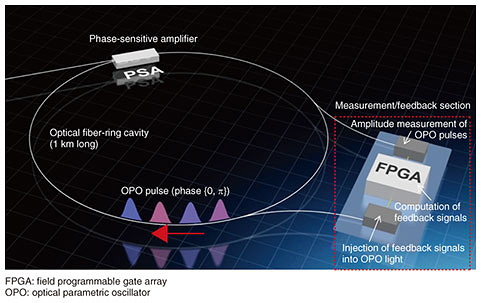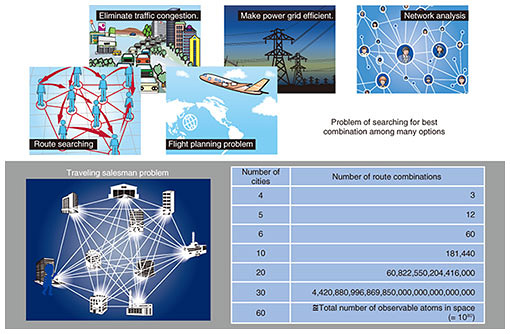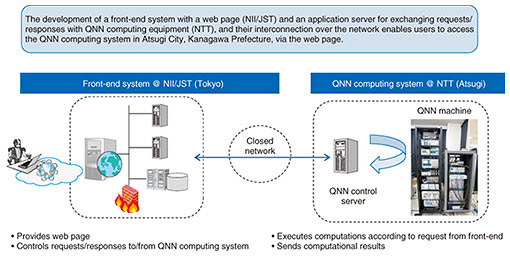 |
|||||||
|
|
|||||||
|
Front-line Researchers Vol. 16, No. 8, pp. 1–6, Aug. 2018. https://doi.org/10.53829/ntr201808fr1 
Changing the World through Basic Research on Light Demands a Pioneering Spirit and Results beyond the OrdinaryOverviewThe pace of achieving further advancements in digital computers is slowing down, but research and development of new types of computers is accelerating throughout the world. NTT has achieved a coherent Ising machine that enables high-speed computation based on phase transition phenomena in laser oscillators. Dr. Hiroki Takesue, Senior Distinguished Researcher at NTT Basic Research Laboratories, received the Nishina Memorial Prize in 2017, a prize awarded to researchers with outstanding achievements in physics and its applications. We asked him about his pioneering research results that could lead to solutions to a variety of problems facing modern society and his mind frame as a researcher. Keywords: Ising model, combinatorial optimization problem, quantum neural network Research crossing many fields—Dr. Takesue, please accept our congratulations on receiving the Nishina Memorial Prize. Can you tell us something about the research that resulted in you earning this award? Thank you very much. I was quite surprised to learn that I would be receiving this prestigious prize, which is usually given out for research already recognized by many people as having great value. I didn’t think that our research that is now just starting to blossom would be a target of this award. I am truly humbled by being selected, but I look upon this prize as an expression of encouragement from the research community that will help our team to carry on with great resolve. At the same time, I feel it is my duty to uncover the true essence of this research and to determine what kind of value it can provide. The research theme that led to this prize being awarded was centered on achieving a large-scale coherent Ising machine (CIM). This is a type of computer used to solve through physical experiments the problem of determining the minimum energy state in an Ising model, which is a theoretical model describing a group of spins that mutually interact with each other. We have achieved a CIM that can compute this Ising model at high speed using a special laser light instead of spins (Fig. 1).
A spin is a physical quantity that we can think of as a tiny magnet that can take on either of two values: up or down. A CIM simulates a spin by a laser light that assigns phase zero to a spin-up state and phase π to a spin-down state. However, ordinary lasers take on any phase value from 0 to 2π, so using such a laser to represent spins requires precise phase control, which is not an easy task. Therefore, we decided to use a special type of laser called an optical parametric oscillator (OPO). When oscillating, an OPO can take on only a phase of 0 or π, which enables stable representation of spins. By using this OPO to generate 2000 optical pulses within an optical fiber-ring cavity whose length is as long as 1 km and applying feedback to those pulses based on the measurement results, we achieved a computer that could instantaneously solve a combinatorial optimization problem (Fig. 2) using 2000 artificial spins that exhibit complex interactions with each other.
Modern society is becoming increasingly networked in complicated ways and thus provides various situations that correspond to combinatorial optimization problems. The aim here is to derive an optimal or a near-optimal combination from a massive number of options originating in various types of elements and information. Typical examples include selection of an optimal route for a delivery truck and optimal allocation of channels in wireless communications. A classic example of this type of problem is the traveling salesman problem, in which the objective is to find the route that minimizes the distance a salesman has to travel when seeking to visit each of a number of cities only once and return to the starting point. If there are only 5 cities to visit, there will be 12 combinations, but for 10 cities, the number of combinations balloons to an enormous number of about 180,000. If we attempt to solve this problem by brute-force computations of multiple combinations, the number of combinations will increase in an exponential manner as the number of options becomes larger, which means that those computations would require a huge amount of time. It is known that many such combinatorial optimization problems can be converted to the problem of searching for the minimum energy state in the Ising model, a well-known theoretical model in statistical physics. We kept this in mind when we adopted the approach of “experimentally solving” this Ising model problem using an actual physical system, which would therefore enable us to solve at high speed a variety of combinatorial optimization problems. We have demonstrated that high-speed solution searching of an Ising model problem consisting of 2000 spins can be performed using a CIM [1]. The results of this experiment were well received by the academic community and were presented in the American journal Science in 2016 [2]. Incidentally, I would like to point out that CIM operation was still unstable as of 2016, which meant that computations had to be constantly adjusted by a researcher. In November 2017, however, we succeeded in achieving long-term stabilization of a CIM for the QNN (Quantum Neural Network) cloud [3] that enables general users to experience computations by CIM for themselves. This service was achieved in collaboration with the National Institute of Informatics (NII), the University of Tokyo, and the Japan Science and Technology Agency (JST) (Fig. 3).
—Do you remember the moment you obtained results with your CIM? Yes, I remember it well. The first time we generated a large-scale OPO pulse group, we just wanted to see what would happen, but we were surprised at the results we obtained, saying: “It’s working!” We did not expect to have progressed that far in our work at that point. Then, when we first obtained computational results, we really didn’t know how to go about evaluating them. These were results that were outside the bounds of fields like quantum optics and photonics that we had been researching up to then. We therefore spent several months discussing these results with researchers in other fields such as computer science, and once we were able to confirm that they represented a solution, I was truly relieved. Although this research was part of a national project, we were taking a great risk not knowing whether we could actually obtain a solution, and I felt responsible for the outcome. On the other hand, I remember it as a time in which we realized that we took up the challenge of interdisciplinary research including the establishment of an evaluation index. —Where do you think the significance of this research lies? Information technology (IT) has been progressing by leaps and bounds these last 20 to 30 years supported by an exponential jump in computer performance. Today’s computers are nothing like the computers of 30 years ago, but further evolution according to Moore’s law appears to be coming to an end, suggesting that computer development has peaked. Meanwhile, IT networks such as the social networking services that we have come to use daily are becoming increasingly complex, and to make them more efficient, we need to find good solutions from combinations of all sorts of elements and options. Obtaining solutions to such problems using conventional computers is extremely difficult, so if a path to solving them by another approach can be found, it might be possible to break through the limits of Moore’s law. Building a bridge between needs and seeds—Your research seems to be on the path toward revolutionizing society. To that end, how will you approach this research and how do you see it developing going forward? We are currently faced with two main research problems. One is clarifying the essence of a CIM—what exactly is it? That is, I would like to clarify for ourselves the nature of a machine that couples thousands of laser pulses and solves complex problems and what, in any, are its limits. The other problem is how to make not only academic contributions but contributions to society as well. As a new technology, the significance of CIM is still up in the air, so there are many challenges that we must face. The number of researchers in this field is small even from a global perspective, and even though we are striving to make this machine useful to the world, we must realize that, in the end, it will be society that decides the value of this research. Another way of describing this approach is “seeds oriented.” “Needs,” of course, are also important, but much of basic research is pursued without knowing how useful it might be to society, so it truly is a seeds-oriented endeavor. Basic research may include many failures, but it holds the possibility of creating something new. Indeed, an innovative development can be thought of as something previously unknown to the world. Something that we try out even though we don’t understand it or something that suddenly appears much like a mutation may end up changing the world. I myself work on the seeds side, but since I have experienced the importance of both, I can also see myself as building a bridge between seeds and needs. Yet, when asked about the significance of pursuing combinatorial optimization problems, I am being totally honest when I say that they may hold the key to solving the problems plaguing modern society. This reason, however, is more of an afterthought since my research is initially driven by something that is “interesting” to me. Performing optical experiments is what I like best. I also feel that researching light is a way of opening my “window to the world.” Personally, it’s not just about science and physics. Through research, I experience a somewhat vague feeling of wanting to know more about the world and human beings. Actually, I sometimes feel that knowledge obtained through optics research is somehow connected to that obtained in completely different fields. This is when I sense that my research relates to learning about people and the world. Learning from the environment and making decisions—Can you tell us what put you on the path toward the life of a researcher? It was the fascination I felt for the dual nature of light, that is, the contradictory wave nature and particle nature of light, in my fourth year of university. This feeling came about through an interference experiment I conducted using photons. I remember the excitement I felt in the pit of my stomach as I said to myself “This is it—the photon/quantum nature of light!” I had this feeling that light could serve to vividly depict the essence of physics, and I developed a burning desire to become a researcher. Actually, when I entered university, I initially had no vision for the future and was simply a student more interested in clubs and extracurricular activities than studies. What transformed me was my encounter with Prof. Tetsuro Kobayashi, a student supervisor, and Prof. Masahiro Kitagawa, an NTT alumnus, who were involved in an optical measurement experiment using lasers in the laboratory that I had been assigned to. I’m the type of person that can become completely absorbed in one thing, and for me, that was laser experiments, and it was at that time that I resolved to pursue the life of a researcher. I later joined NTT with an eye to becoming a researcher, but at that time, graduates of master’s programs were first assigned to an NTT branch office for training and an aptitude assessment, which is what happened to me. While working at that branch office, I longed for the day that I would become a researcher. On completing my training, I was told that I would be assigned to a research laboratory, which I was extremely glad to hear. However, my joy was short lived, as I was assigned to a laboratory in Tokai, Ibaraki Prefecture, which was different from what I had hoped for, and to a position involving optical fiber measurements and the like. At first, I felt dissatisfied with my work, but before long, I came to appreciate the abilities of the researchers around me. I was also blessed with great superiors, and I changed my way of thinking, saying to myself: “I’m going to make an effort to follow in their footsteps!” I became highly motivated in my third year there. I later moved to a research laboratory in Tsukuba, where it was decided that I would be involved in the development of a wavelength multiplexing access network called Tsukuba WAN (wide access network). This was a cutting-edge, epoch-making undertaking for its time, but given my strong desire for basic research, I again started out with a somewhat negative attitude, thinking: “What am I doing here?” However, on working with specialists from other NTT laboratories on this project, I started to notice the high professional level of their work. All in all, it was a joint effort between optical-network researchers and specialists, in which the former had to understand all aspects of the technology and design the network in detail, while the latter had to grasp the entire project, organize many people, push the project forward, and draw up specifications. These were people with completely different specialties who were each very competent in their work. Compared with them, I felt quite mediocre in what I was doing and made up my mind to pursue basic research in my own way. Looking back, I think that if I had been directly assigned to NTT Basic Research Laboratories and started out on a researcher’s path from the start, my present research style would not have developed the way that it did thanks to these experiences. —So instead of being a detour, it was a period that cultivated your present research style and individuality. Dr. Takesue, what would you say to young researchers based on your experiences? I believe that basic research is a field that requires “results beyond the ordinary.” Visitors to the NTT laboratories enjoy hearing about the new seeds that we have uncovered in our research. Seeing their reaction to our achievements makes me realize that researchers in this field must have a pioneering spirit ready for unforeseen results. This is what I would like to say to young people based on my experiences and character: even if you should find yourself in a less than satisfactory situation, you should be able to learn something from that environment and the people around you. I would like you to persevere in such a situation and take the time to look around you. If you notice nothing positive at all, you may think it’s best to quit, but the NTT laboratories have no shortage of places where you can learn many things. At the same time, I would like young researchers to have the courage to make decisions and take action. In my seventh year at NTT, the opportunity to move to NTT Basic Research Laboratories—as I had long desired—finally arrived, but I also felt some fear of making a change. At that time, I associated NTT Basic Research Laboratories with very high-level research, and with only a master’s degree level of knowledge in quantum physics, I wondered if I could fit in, and I thought that I would certainly be treated as a freshman despite being over 30. I was therefore filled with a lot of anxiety. Perhaps such fear is normal when making a life change, but thankfully, curiosity and a desire to take on a new challenge finally won out. As a result, I now feel that I can research freely to my heart’s desire in a new field. When a yearning to make a change springs up in you, I think you will obtain better results by being honest with yourself than by falling victim to your fears. Finally, I would ask young researchers in a new field to welcome challenges, since they can be great opportunities for success. Researchers in a field having a long history and a proven track record may have a sense of security, but there will be many forerunners in that field with great achievements, which means that unfinished work will be extremely limited. A new field, in contrast, can be thought of as a “broad ocean” with few researchers who have already uncovered value. A new field may be risky, but it should also present many opportunities for young researchers to succeed. References
■Interviewee profileHiroki TakesueSenior Distinguished Scientist (Senior Distinguished Researcher), Group Leader, Quantum Optical State Control Research Group, Optical Science Laboratory, NTT Basic Research Laboratories. He received a B.E., M.E., and Ph.D. in engineering science from Osaka University in 1994, 1996, and 2002. In 1996, he joined NTT, where he engaged in research on lightwave frequency synthesis, optical access networks using wavelength division multiplexing, and quantum optics. He is currently pursuing research on communication and computation using quantum optics technologies. He is the recipient of several awards, including the ITU-T (International Telecommunication Union - Telecommunication Standardization Sector) Kaleidoscope Conference 2nd Best Paper Award in 2008, The Commendation for Science and Technology by the Minister of Education, Culture, Sports, Science and Technology of Japan (The Young Scientists’ Prize) in 2010, and the Nishina Memorial Prize in 2017. He was a visiting scholar at Stanford University, California, USA, from 2004 to 2005, and a guest researcher at the National Institute of Standards and Technology, Colorado, USA, in 2014. He is a Guest Professor in the Graduate School of Engineering Science, Osaka University, and a member of the Institute of Electrical and Electronics Engineers and the Japan Society of Applied Physics. |
|||||||











